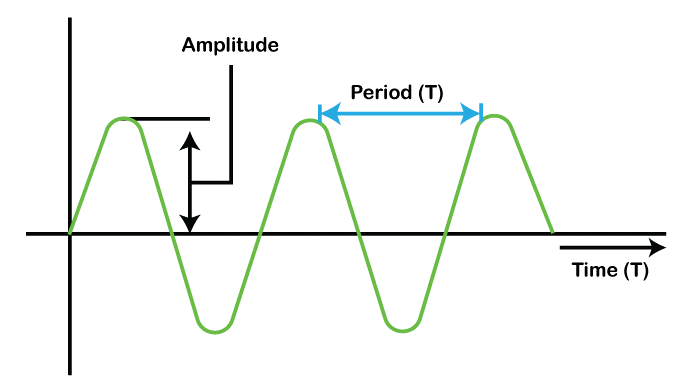Amplitude DefinitionAmplitude is a fundamental concept in physics, which is used to describe the characteristics of various types of waves, including sound waves, electromagnetic waves, and mechanical waves. In simple terms, amplitude refers to the maximum displacement of a wave from its equilibrium position. In other words, it is the distance between a wave's crest (peak) and trough (valley). 
To understand the concept of amplitude in greater detail, it is necessary to understand the nature of waves. A wave is a disturbance that travels through a medium or space, carrying energy from one point to another. All the waves can be categorized into two main types: longitudinal and transverse waves. In a longitudinal wave, the displacement of the particle remains parallel to the direction of propagation of the wave, whereas, in a transverse wave, the displacement of the particle is perpendicular to the direction of wave propagation. Examples of longitudinal waves include sound waves in the air, ultrasound, tsunami waves, primary waves of earthquakes, etc. Examples of transverse waves include water waves, electromagnetic waves, waves on a string, etc. In a sound wave, the amplitude corresponds to the maximum pressure variation from the atmospheric pressure. In a water wave, the amplitude corresponds to the full height of the wave above the water's placid surface. In an electromagnetic wave, the amplitude corresponds to the maximum electric or magnetic field strength. The amplitude of a wave can be measured in several different ways, depending on the type of wave and the context in which it is being studied. The amplitude is generally measured in distance units, such as meters or centimetres, or units of pressure or electric-magnetic field strength, such as Pascal or volts per meter. The formula for Amplitude CalculationThe amplitude is calculated by entering the required values in the formula below: x = Asin? ?t + ? Here, 'x' represents displacement in meters, 'A' represents amplitude in meters, ? refers to the angular frequency in radians/second, t represents time in seconds, and ? represents phase shift in radians. It is important to note that amplitude is always positive because distance can only be equal to zero or greater than zero, but not negative. PropertiesOne important property of amplitude is that it is directly related to the energy carried by a wave. In other words, waves with higher amplitudes have more power or energy than waves with lower amplitudes. Another important property of amplitude is that it can affect the behaviour of waves when they encounter obstacles or boundaries. For example, when a sound wave encounters a wall, the amplitude of the wave decreases as the wall absorbs the sound energy. Similarly, when an electromagnetic wave encounters a metal surface, the wave's amplitude can be reflected or absorbed by the metal, depending on the metal's properties and the wave's frequency. What is the use of amplitude in sounds?In sound, the amplitude is a crucial parameter that determines the loudness or intensity of the sound. The amplitude of a sound wave corresponds to the maximum displacement of air particles from their resting position caused by the sound wave's vibrations. The amplitude of a sound wave can be measured in different ways, including peak amplitude, peak-to-peak amplitude, and root means square (RMS) amplitude. Peak amplitude is the maximum displacement of air particles from their resting position in a sound wave. In contrast, the peak-to-peak amplitude is the difference between air particles' top and minimum displacement. RMS amplitude is the square root of the average of the squares of the instantaneous amplitude of a sound wave over a given time interval. The amplitude of a sound wave can be manipulated to achieve specific effects in music and audio engineering. For example, increasing the amplitude of a sound wave can increase its loudness, while decreasing the amplitude can reduce the loudness. This is achieved through amplification or attenuation of the sound wave. In music production and audio engineering, amplitude manipulation is often used to create a dynamic range between the loudest and softest parts of a sound recording. By decreasing the amplitude of the noisy components and increasing the amplitude of the delicate details, engineers can increase the dynamic range of a recording, making it sound more exciting and dynamic. In addition to its use in music and audio engineering, the amplitude of sound waves has practical applications in many areas, including medicine, where it is used in diagnostic ultrasound imaging, and industrial noise control, which is used to measure and reduce noise levels in industrial environments. Overall, the amplitude of a sound wave is a critical parameter in sound, and its manipulation is essential for achieving specific effects in music and audio engineering and other practical applications of sound. ConclusionFinally, amplitude is a fundamental concept in physics that is used to describe the maximum displacement of a wave from its equilibrium position. It measures the energy of the wave and can affect the behaviour of the wave when it encounters obstacles or boundaries. The concept of amplitude is important in many fields of science and engineering, including acoustics, optics, and telecommunications.
Next TopicCardiac Output Definition
|
 For Videos Join Our Youtube Channel: Join Now
For Videos Join Our Youtube Channel: Join Now
Feedback
- Send your Feedback to [email protected]
Help Others, Please Share










